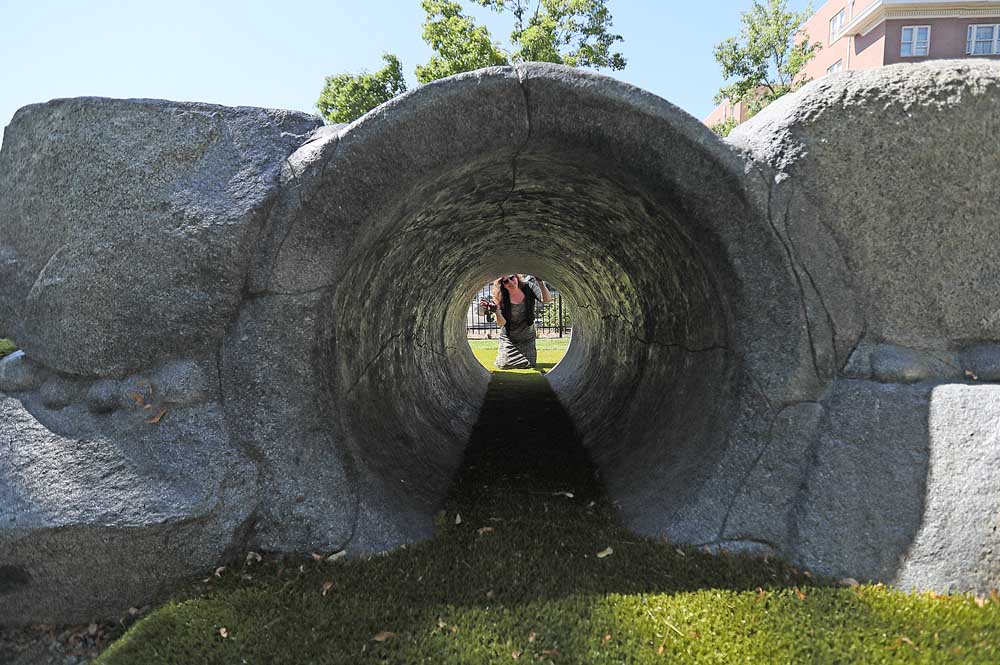Outdoor play area nearly complete at Children’s Museum in Medford
Published 4:15 pm Tuesday, July 11, 2023

- Sunny Spicer, executive director of the Children's Museum of Southern Oregon in Medford, points out new features of the outside play area Monday.
Children of all ages will have a new outdoor space to play and learn in the middle of downtown Medford — as soon as enough steel arrives to finish the project’s towering treehouse and 8-foot-tall flower sculptures.
Trending
“Little kids will come up and pull on the bars of the fence, and constantly people come up to the front desk and ask, ‘When is it going to be finished?’ We’re getting close. We will be open this summer,” said Sunny Spicer, executive director of the Children’s Museum of Southern Oregon, formerly known as KidTime.
Supply chain delays have drawn out the $3.5 million construction project, Spicer said, but she hoped the space at 413 W. Main St. will be able to welcome visitors in the coming weeks. With the outdoor space, the nonprofit organization can expand its capacity to offer play-based learning — a service that has increased in demand since the pandemic’s long months of isolation, she said.
The waiting list for the Ivy School — the nonprofit’s preschool — is so long that three children are waiting for every spot, Spicer said.
Trending
“Hopefully this will allow us to offer something comparable and accessible. It’s the same instructors teaching classes and working in the museum,” she said.
The outdoor play area is designed along the same principles that make the Ivy School and the museum tick — a respect for the importance of learning through doing, especially in natural settings.
“You need to get them real things and show them and let them have that problem-solving,” Spicer said.
“Studies have shown the importance of a connection to nature, natural spaces are vital to the learning process. It builds more empathy, a stronger ability to connect with other people and a stronger sense of self.”
The frequency of households living in cities with two busy working parents can mean children have less access to natural spaces.
“We’ll bring it to them,” she said.
Walking through the 5-foot-high black iron fence that protects the play area Monday afternoon, Spicer pointed out all the elements in the space and the thought behind them.
A pathway winds around the perimeter. Towering in the center is a treehouse still under construction. Surrounding it is play equipment made largely of wood, designed for children to climb around and over to their heart’s content.
Running parallel to one side of the fence is a long, low hill of grass in two colors. On closer inspection, half the grass is real, half synthetic. Natural grass stays cooler in the heat, but synthetic holds up better to play, Spicer said. A tunnel is cut under the slope where little ones can crawl through.
Where the hillside faces the corner of the fence is a child-sized amphitheater. An impressive lineup of intended events is already slated for the space — from story time to yoga, robotics lessons from Talent Maker City and performances from the Rogue Valley Symphony.
The symphony is also eager to come out for the newly installed forest of instruments just around the corner from the amphitheater. The tall chimes, steel drums, xylophones and cajons — recently arrived and installed — shine under still-intact plastic wrap.
“These aren’t your typical playground musical instruments that don’t sound good. These are real instruments. You can really play these,” she said.
All along the fence and framing the edges of the romping-proof “grass” is a narrow garden with numerous little lavender bushes. These plants are part of the sensory garden, she said. Kids are encouraged to touch and smell.
An artificial stream runs in a crescent shape around an enormous sand pit where kids can get the full benefit of sand’s tactile qualities. The connection between these two features speak to the heart of what the museum’s space offers.
“At first I thought, ‘Oh, no, we can’t have the river so close to the sand, we’ll have sand in this all the time,’ But then I thought, ‘This is what we do. It’ll be a maintenance nightmare, but kids need to have this,’” she said.
For very young children learning the mechanics of the world, there’s no better way to learn to problem-solve than to try, feel, fail and try again.
“They need to be able to build a boat, watch it go down the stream, fail, then tinker it up and do it again,” she said.
The fence around the carefully kid-designed space creates a level of safety meant to inspire parents to step back and relax in a special seating area designed for them. Here, their children can be “free range” without hovering or help.
At the farthest edge of the space is an area where construction has hardly begun. Here there will be a roughly 1,200-square-foot outdoor classroom and events center, were kids of all ages can enjoy the intersection of learning and play.
When asked about restrictions like closing for weather or age limits, Spicer said the space will be open more often than not.
Like the preschool, within its given hours of operation kids can enjoy the space rain or shine. As far as what defines a “kid,” technically the museum’s programs focus on early childhood. But siblings are encouraged to play together regardless of age, and the space has already brought out the inner child in many of its visitors.
“I expect adults to be out here. People come in and they’re like, ‘Ooh look at all this!’” Spicer said.
Once construction is complete, the museum plans to hold a grand opening celebration. For more information about the museum, see www.tcmso.org









